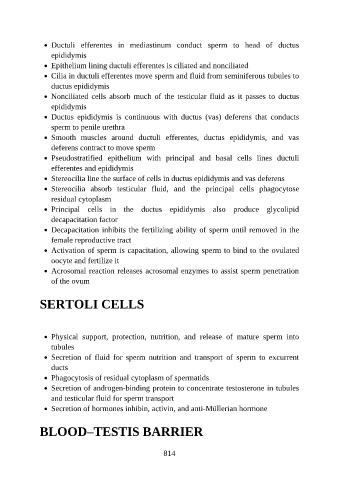Page 815 - Atlas of Histology with Functional Correlations
P. 815
Ductuli efferentes in mediastinum conduct sperm to head of ductus
epididymis
Epithelium lining ductuli efferentes is ciliated and nonciliated
Cilia in ductuli efferentes move sperm and fluid from seminiferous tubules to
ductus epididymis
Nonciliated cells absorb much of the testicular fluid as it passes to ductus
epididymis
Ductus epididymis is continuous with ductus (vas) deferens that conducts
sperm to penile urethra
Smooth muscles around ductuli efferentes, ductus epididymis, and vas
deferens contract to move sperm
Pseudostratified epithelium with principal and basal cells lines ductuli
efferentes and epididymis
Stereocilia line the surface of cells in ductus epididymis and vas deferens
Stereocilia absorb testicular fluid, and the principal cells phagocytose
residual cytoplasm
Principal cells in the ductus epididymis also produce glycolipid
decapacitation factor
Decapacitation inhibits the fertilizing ability of sperm until removed in the
female reproductive tract
Activation of sperm is capacitation, allowing sperm to bind to the ovulated
oocyte and fertilize it
Acrosomal reaction releases acrosomal enzymes to assist sperm penetration
of the ovum
SERTOLI CELLS
Physical support, protection, nutrition, and release of mature sperm into
tubules
Secretion of fluid for sperm nutrition and transport of sperm to excurrent
ducts
Phagocytosis of residual cytoplasm of spermatids
Secretion of androgen-binding protein to concentrate testosterone in tubules
and testicular fluid for sperm transport
Secretion of hormones inhibin, activin, and anti-Müllerian hormone
BLOOD–TESTIS BARRIER
814

